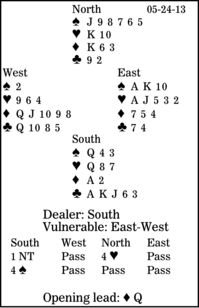Bridge column, May 24: With six in a major, make it trumps

However, when the responder has six (or more) in his major, he should insist on that suit being trumps because he knows his side has at least an eight-card fit. But how does he do that over one no-trump?
If he has invitational strength, he transfers at the two-level, then bids three of his suit. If he wishes to play in four of his major, he makes his transfer at the four-level -- a Texas transfer, as in today's deal. If the responder has mild slam ambition, he transfers at the two-level, then jumps to four of his major. If he wants to get to a slam, he uses Texas and bids again.
Here, North's insistence on game is slightly aggressive, but 10 tricks could be laydown opposite the right 15-count. Against four spades, West leads the diamond queen. What should South do?
Declarer must lose two spades and one heart. But dummy also has a diamond loser. South should win with his diamond ace (the honor from the shorter side first), play a diamond to dummy's king, and ruff the last diamond in his hand. Then, with this layout, South must next lead a heart to drive out East's ace so that he can make his first trump play from the dummy through East.
** ** **
COPYRIGHT: 2013, UNITED FEATURE SYNDICATE
DISTRIBUTED BY UNIVERSAL UCLICK FOR UFS

